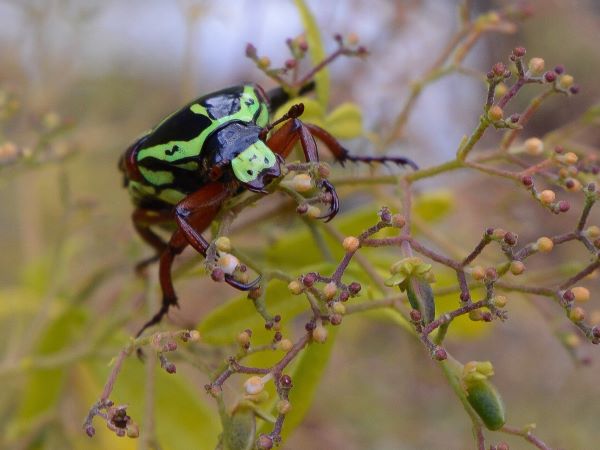As a child, I remember my backyard garden being nothing but a place of discovery. Somewhere where my imagination and curiosity for the natural world were born. I remember every leaf, log and rock as being an opportunity to find something new and unseen by my eyes. The variety of critters a curious child can find in a 1980’s country town backyard is astounding. Of all the things I would find I remember the insects being the most curious group of all. When the warm weather arrived in early spring so would the endless variety of six legged creatures of every type for me to find. Many avid gardeners go into a state of panic when they think of insects in their garden as there is a belief that an insect equals a pest, an enemy to our plants, but the truth of the matter is that the vast majority of insects in your garden are either beneficial or benign, probably the former. Of all the insects I would stumble upon the beetles were my favourite, this was probably because you can easily observe them without getting stung or bitten. It’s been a few years now since I was a child and those moments of excitement from discovering something new aren’t as common now as they were then but I will never forget the moment in my adult life when I first stumbled across one of these guys and thought to myself “what are you and what planet are you from?”. The Fiddler Beetle (Eupoecila australasiae).
Fiddler Beetles, who get their names from the bright green or yellow Violin shaped pattern on their black backs are members of the subfamily Cetoniinae commonly known as flower chafers. They are 1.5cm to 2cm in length, very capable flyers and can be found in the Heathlands and Eucalyptus Woodlands of South Eastern Australia or any backyards where these vegetation types would naturally occur. Adults emerge from the soil in early summer to feed on nectar-laden flowers before returning to the ground to mate and lay their eggs. Female Fiddler Beetles lay their eggs in rotting logs or in the damp soil. Once hatched, the larvae eat rotting wood until they mature and pupate there by making a cocoon-like chamber from rotting timber and soil.
What’s their ecological role in your garden?
There are literally countless ecological processes and relationships going on this very moment in your backyard so to truly understand how and where the Fiddler beetle fits in this elaborate web is quite a task, but here are a few key points.

- Recycler: Fiddler Beetle larvae are detritivores which are animals that feed on dead organic material, in this case dead plant materiel. So they play a role as a recycler, recycling what is essentially plant waste and replenishing the soil.
- Pollinator: As the Fiddler Beetle moves through the flowers seeking nectar to feed on, it collects and transports pollen to where it’s needed for fertilization. Without this fertilization new seeds will not be viable so the Fiddler Beetle plays a role in ensuring that future generation of the host plant are secured.
- Food source: Like other beetles, the Fiddler will provide a food source to many other fauna in your garden including birds like Butcher Birds and Kookaburras, reptiles like Eastern Water Dragons and Blue Tongued Lizards and even the odd mammal like the Brown Bandicoot.
How to encourage them into your backyard.
Planting a wide variety of nectar bearing, locally native plants will encourage these guys into your garden. While it’s likely that they feed on many different species, three local species of plants known to host these beetles are; the Lemon Scented Myrtle – Backhousia Citradora (to 20m), the Smudgee – Angophora woodsiana (to 20m) and the Narrow Leaf Paperbark – Melaleuca linariifolia (to 10m). Also having a good layer of litter on the garden floor will provide suitable breeding habitat.
Factors that could threaten this species.
- Climate Change: Warmer conditions, as a result of climate change, could mean that beetle larvae develop more quickly and become adults sooner. If their food sources don’t also start flowering earlier, there is a possibility that the beetles will have to change their feeding behaviour or their populations could diminish ( climatewatch.org.au ).
- Habitat loss: As with many other species, habitat loss as a result of clearing for development is the greatest and most immediate threat to these beautiful beetles.
- Domestic Pets: New research conducted by the Australian Government’s National Environmental Science Program has found that collectively, domestic cats kill 390 million animals per year (Threatened Species Recovery Hub). This figure doesn’t include insects but I’m sure you can imagine how a cat would treat a beetle so remember to control your pets.
Check out these links for more info on the bugs in your backyard
- http://anic.ento.csiro.au/insectfamilies/
- https://www.qm.qld.gov.au/Explore/Find+out+about/Animals+of+Queensland/Insects/What+insect+is+that
Photo Credit: Sarah Hibberd, Australian Museum.
By Ryan Heeney
Environment Officer | Noosa Council


